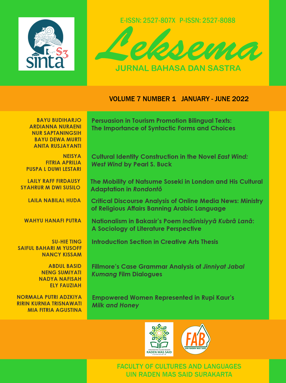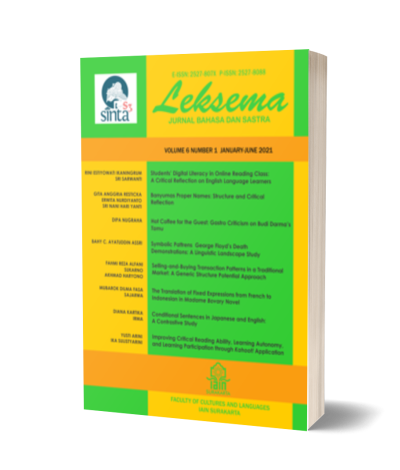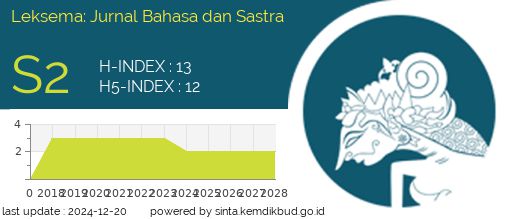EMPOWERED WOMEN REPRESENTED IN RUPI KAUR’S 'MILK AND HONEY'
DOI:
https://doi.org/10.22515/ljbs.v7i1.5015Keywords:
empowered, feminism, patriarchy, womenAbstract
This paper is the result of the analysis on Rupi Kaur’s poems compiled in her book entitled Milk and Honey. It focuses on how Kaur portrays women from their breaking to healing stages until finally they become strong and empowered figures. This study employed a qualitative-descriptive method for analyzing the poems. By her poems, Kaur speaks her thoughts about women’s representation in society. She also criticizes the patriarchal ideology that places women as the servant for men’s pleasure. Her works illustrate problems that oppress women such as sexual objectification, mental trauma, and family with patriarchal culture. Throughout the book, Kaur also reveals the journey of women from being hurt to be finally healed and become empowered.
Downloads
References
Betz, O. 1995. “Considerations on the Real and the Symbolic Value of Gold. In: Morteani Giulio & Jeremy P Northover. (eds.) Prehistoric Gold in Europe: Mines, Metallurgy and Manufacture. NATO ASI Series (Series E: Applied Sciences) 280. https://doi.org/10.1007/978-94-015-1292-3_3
Calogero, Rachel M, Michael Boroughs & Joel Kevin Thompson. 2007. “The Impact of Western Beauty Ideals on the Lives of Women: A Sociocultural Perspective”. The Body Beautiful: Evolutionary and Sociocultural Perspectives. V Swami & A Furnham (eds.) Palgrave Macmillan. DOI:10.1057/9780230596887_13
CBS This Morning. 2018. “Best Selling ‘Instapoet’ Rupi Kaur on Feminism, Being a Woman of Colour”. February 26
Dandona, Anu. 2015. “Empowerment of Women: A Conceptual Framework”. The International Journal of Indian Psychology 2 (3): 35-45. DOI: 10.25215/0203.044
Davis, Stefanie E. 2018. “Objectification, Sexualization, and Misrepresentation: Social Media and the College Experience”. Social Media + Society. DOI: 10.1177/20563051187867
Deka, Thrisna. 2020. “Multifaceted Feminist Perspectives: Interpreting Milk and Honey by Rupi Kaur”. Humanities & Social Sciences Reviews 8 (4): 608-615. DOI: 10.18510/hssr.2020.8460
Dey, Ian. 1993. Qualitative Data Analysis: A User Friendly Guide for Social Scientists. Routledge
Effiong, Angelica & Sylvia Inyang. 2020. “A Brief History and Classification of Feminism”. In Egbai Oluwagbemi-Jacob, Abakedi & Effiong (eds.) A General Introduction to Feminism and Feminist Philosophy
Finkelhor, David. 1999. “Child Sexual Abuse. Challenges Facing Child Protection and Mental Health Professionals”. In Elizabeth Ullman, Werner Hilweg, Mary Heaney Margreiter, Kira Henschel (eds.) Childhood and Trauma: Separation, Abuse, War. Routledge: 101-116
Fredrickson, Barbara L & Tomi-Ann Roberts. 1997. “Objectification Theory: Toward Understanding Women’s Lived Experiences and Mental Health Risks”. Psychology of Women Quarterly 21 (2): 173-206. DOI: 10.1111/j.1471-6402.1997.tb00108.x
Gelling, Leslie. 2013. “A Feminist Approach to Research”. Nurse Researcher. 21 (1): 6-7 DOI:10.7748/nr2013.09.21.1.6.s2
Jindal, Madhu. 2017. “Going beyond the Narrative: Rupi Kaur's Milk and Honey as a Modern Text”. International Journal of Advanced Research and Development 2 (6): 800-802
Kaur, Rupi. 2015. Milk and Honey. Andrew McMeel Publishing
Kaur, Rupi. (n.d.). The Making of… Milk and Honey. https://rupikaur.com/pages/milk-and-honey
McQuillan, David. 2018. Aesthetic Scandal and Accesibility: The Subversive Simplicity of Rupi Kaur's Milk and Honey. Halifax: Dalhousie University
MacLeod, M, & Saraga, E (eds.). 1988. Child Sexual Abuse: Towards a Feminist Professional Practice. London: PNL Press
McKinnon, Sara. 2014. “Text-Based Approaches to Qualitative Research: An Overview of Methods, Process, and Ethics”. The International Encyclopedia of Media Studies,VII. DOI: 10.1002/9781444361506.wbiems185
Szymanski, Dawn M, Lauren B Moffitt, Erika R Carr. 2011. “Sexual Objectification of Women: Advances to Theory and Research”. The Counseling Psychologist. Sage. 39 (1): 6-38. DOI: 10.1177/0011000010378402
Tikkha, Neelam. 2018. “Lonely Voice of a Goddess - A Critical Analysis of Rupi Kaur’s Collection of Poems Milk and Honey”. International Journal of English Language, Literature and Translation Studies (IJELR) 5 (S1): 5-15
UKEssays. 2018. The Status of Women in Patriarchal Indian. https://www.ukessays.com/essays/sociology/the-status-of-women-in-patriarchal-indian- sociology-essay.php?vref=1
Widjaja, Ayura Putri. 2020. An Analysis on Women Objectification in Rupi Kaur's Milk and Honey. Surabaya: Universitas Airlangga Repository. http://repository.unair.ac.id /102054/
Downloads
Published
Issue
Section
License
Copyright (c) 2022 Leksema: Jurnal Bahasa dan Sastra

This work is licensed under a Creative Commons Attribution-NonCommercial-ShareAlike 4.0 International License.
The copyright of the received article shall be assigned to the publisher of the journal. The intended copyright includes the right to publish the article in various forms (including reprints). The journal maintains the publishing rights to published articles.
In line with the license, the authors and users (readers or other researchers) are allowed to share and adapt the material only for non-commercial purposes. In addition, the material must be given appropriate credit, provided with a link to the license, and indicated if changes were made. If authors remix, transform or build upon the material, authors must distribute their contributions under the same license as the original.







